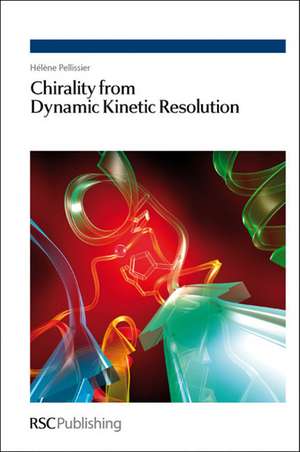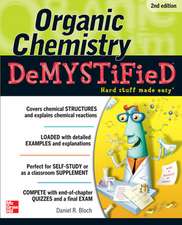Chirality from Dynamic Kinetic Resolution
Autor Helene Pellissieren Limba Engleză Hardback – 31 mar 2011
The last 15 years have witnessed significant developments in the efficiency and scope of the application of DKR. These now offer a serious alternative to conventional methods for asymmetric synthesis. Indeed, impressive examples using new enzymes and major progress in the DKR of racemates have taken place over the past few years. The powerful combination of enzymes and metals has also been the subject of spectacular development. In addition, a new type of DKR, involving organocatalysts, has recently appeared. Although asymmetric catalysis has undergone development during the last two decades, the most common industrial process used to obtain enantiomerically pure compounds is still via resolution of racemic mixtures. This is despite the major disadvantage that only a maximum of 50% product yield can be obtained. It is not surprising that DKR, which solves the problem of the limitation in yield, has attracted an increasing amount of interest from both the industrial and the academic perspective. This book provides an up-date on the principle methods employed to obtain dynamic kinetic resolution (DKR) by either enzymatic or non-enzymatic methods. It also illustrates the diversity of useful chiral products that can be obtained through this powerful concept. Divided into three sections, the book deals successively with non-enzymatic methods, enzymatic methods, and the use of transition metals and enzymes in tandem.
Preț: 778.85 lei
Preț vechi: 905.64 lei
-14% Nou
Puncte Express: 1168
Preț estimativ în valută:
149.03€ • 155.30$ • 123.40£
149.03€ • 155.30$ • 123.40£
Carte tipărită la comandă
Livrare economică 03-17 aprilie
Preluare comenzi: 021 569.72.76
Specificații
ISBN-13: 9781849731973
ISBN-10: 1849731977
Pagini: 299
Dimensiuni: 158 x 240 x 22 mm
Greutate: 0.53 kg
Editura: Royal Society Of Chemistry
ISBN-10: 1849731977
Pagini: 299
Dimensiuni: 158 x 240 x 22 mm
Greutate: 0.53 kg
Editura: Royal Society Of Chemistry
Cuprins
Introduction; Non-enzymatic methods; Enzymatic methods; Use of transition metals and enzymes in tandem; Conclusions
Notă biografică
Hélène Pellissier was born in Gap, France. She carried out her PhD under the supervision of Dr G. Gil in Marseille and then entered the Centre National de la Recherche Scientifique in 1988. After a postdoctoral position in Professor K. P. C. Vollhardt' group at Berkeley, she joined the group of Professor M. Santelli in Marseille in 1992. Here she focused on the chemistry of BISTRO and its large application in organic synthesis.
Textul de pe ultima copertă
The last 15 years have witnessed significant developments in the efficiency and scope of the application of DKR. These now offer a serious alternative to conventional methods for asymmetric synthesis. Indeed, impressive examples using new enzymes and major progress in the DKR of racemates have taken place over the past few years. The powerful combination of enzymes and metals has also been the subject of spectacular development. In addition, a new type of DKR, involving organocatalysts, has recently appeared. Although asymmetric catalysis has undergone development during the last two decades, the most common industrial process used to obtain enantiomerically pure compounds is still via resolution of racemic mixtures. This is despite the major disadvantage that only a maximum of 50% product yield can be obtained. It is not surprising that DKR, which solves the problem of the limitation in yield, has attracted an increasing amount of interest from both the industrial and the academic perspective. This book provides an up-date on the principle methods employed to obtain dynamic kinetic resolution (DKR) by either enzymatic or non-enzymatic methods. It also illustrates the diversity of useful chiral products that can be obtained through this powerful concept. Divided into three sections, the book deals successively with non-enzymatic methods, enzymatic methods, and the use of transition metals and enzymes in tandem.
Descriere
This book provides an up-date on the methods employed to obtain dynamic kinetic resolution (DKR) by enzymatic and non-enzymatic methods.








